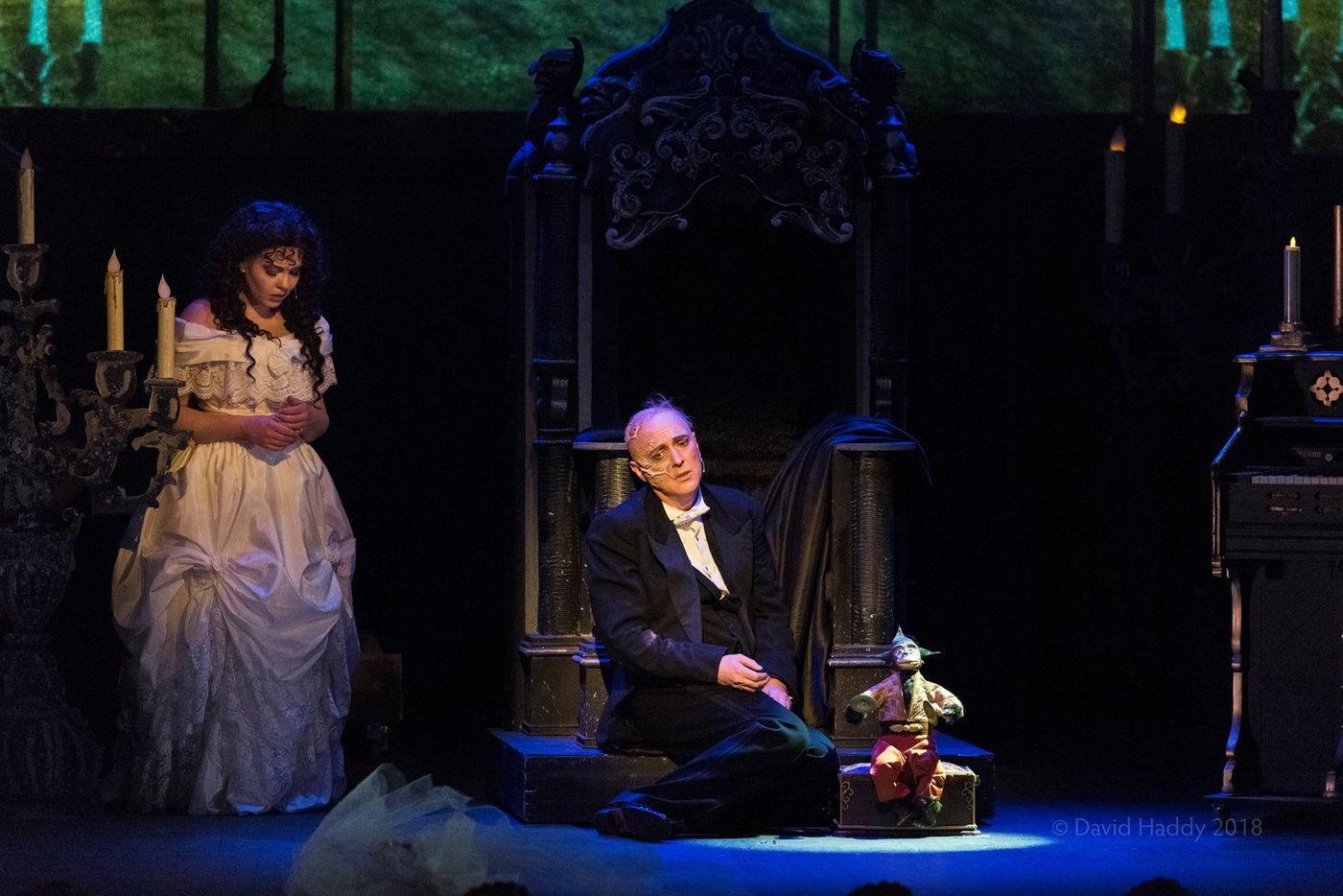Review: THE PHANTOM OF THE OPERA at ARTS Theatre
 Reviewed by Barry Lenny, Sunday 30th September 2018.
Reviewed by Barry Lenny, Sunday 30th September 2018.
The Phantom of the Opera did not begin with Andrew Lloyd Webber in 1986. It has a long history, beginning with a serialised story in Le Gaulois, Le Fantôme de l'Opéra, written by Gaston Leroux between September 1909 and January 1910. It is said to have been inspired by the spurious claim that the skeleton of a dancer had been used in a production of Carl Maria von Weber's Der Freischutz at the Palais Garnier, home of the Paris Opera. It caught the imagination of creative individuals and, in 1925, a wonderfully dark silent film was made, with Lon Chaney Snr. in the titular role. Unlike the musical, the Phantom in earlier presentations has no redeeming features. The semi-happy ending and redemption of Erik, the Phantom, is an invention for the musical. Originally, he was pursued by a mob, to his death by drowning.
The musical has music by Andrew Lloyd Webber, of course, with lyrics by Charles Hart, additional lyrics by Richard Stilgoe, and a book by Richard Stilgoe and Andrew Lloyd Webber. It has been claimed that there is also a debt owed to Puccini. Andrew Lloyd Webber was sued by Puccini's estate for plagiarising music from his opera, La fanciulla del West (The Girl of the Golden West). He settled out of court.
Andrew Lloyd Webber's music softens the Gothic horror style of the original story, with the Phantom's torture chamber, a long string of murders, and the wall of bones of the victims, going without mention. Even so, there is no hiding his mesmeric hold over Christine Daaé, the talented young Swedish soprano. He is her Svengali, bending her to his will through music, possessing her mind, and planning to own her, body and soul. Although he is her mentor, he is also a murderer, kidnapper, mental abuser, egomaniac, psychopath, and more.
Adam Goodburn, who plays the Phantom brings a powerful darkness to the role, in his superb acting, as well as the way in which he uses his singing voice to add menace to the songs. Goodburn is a very popular performer with the State Opera of South Australia and, over the years, he has shown a great versatility, ranging from some hilariously comic roles to serious dramatic ones, such as Gandhi, in Philip Glass's opera, Satyagraha. This, however, is a very different move for him, and he shines in the role. He makes his presence felt, even when not on stage. A brief snatch of song from offstage, and its influence hangs on, the rest of the cast responding to his sinister overtones.
The director of this production from the Gilbert and Sullivan Society, David Sinclair, found a great Phantom, but he did not stop there. His choice of Serena Martino-Williams, for the role of Christine, was a very wise move, and he completed casting the extremely strong trio of central roles with the selection of Jared Frost, as Raoul, Vicomte de Chagny. Sinclair creates powerful emotional interactions between this trio, with the Phantom and Raoul both in love with Christine, and her torn between her love for Raoul and her commitment to her career and her Angel of Music, the Opera Ghost, the Phantom.
Martino-Williams, as Christine, presents all of the anguish of somebody caught in a difficult situation between her love for a man and her love of singing that requires her commitment to her Angel of Music, the Phantom, whom she accepts as a supernatural being promised to be sent from heaven to her by her dying father.
Frost's Raoul is convincing in his love for Christine, showing his concern for her wellbeing, and trying desperately to save her from the Phantom, and from herself. He is every bit the hero when he follows her into the Phantom's underground lair, risking his life to save her from, as they say, a fate worse than death.
Sinclair's work is only one part of the production, with musical director, Jillian Gulliver, and choreographer, Jamie Jewell, contributing strongly to the success of this production, which features a full orchestra and many and varied dance routines. In the Nineteenth Century, when this is set, the heyday of the Diva, operas included interludes of ballets, often with no relationship to the opera itself, a practice that has, thankfully, been long discontinued, although dance is still included in some operas where it is an integrated part of the performance. Sinclair also designed the set, with costumes coordinated by Helen Snoswell, lighting design by Mark Oakley, and sound by Glenn Hill all adding to the very high quality of the production.
It is not only the three central characters that have been well cast. Kaylene Graham is a nicely enigmatic Madame Giry, and Jessica Muenchow is vibrant as her daughter, Meg. Monique Hapgood is a young Carlotta, but carries it of well as the egotistical diva, with James Nicholson presents a very flamboyant as the tenor, Piangi. Between them, they offer humour to this dark tale.
Rod Schultz and David Visentin are Firmin and André, the new owners of the theatre, who discover that they have bought a heap of trouble. They make a good duo and nicely convey the transition from thinking that they are in control, to the realisation that they have no choice but to obey the demands of the Phantom. Even the minor roles offer superb performances, and the chorus and dancers are marvellous.
I would highly recommend that you see this production but, unfortunately, I hear that the second week, like the first, is sold out. You could call the box office, though, in case there have been any cancellations.
Reader Reviews
Videos

